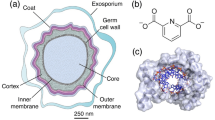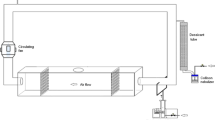Abstract
Recent studies have correlated the presence of Stachybotrys chartarum in structures with SBS. S. chartarum produces mycotoxins that are thought to produce some of the symptoms reported in sick-building syndrome (SBS). Theconidia (spores) produced by Stachybotrys species are not commonly found in the air of buildings that have been found to contain significant interior growth of this organism. This could be due in part to the large size of the Stachybotrys spores, or the organism growing in hidden areas such as wall cavities. However, individuals in buildings with significant Stachybotrys growth frequently display symptoms that may be attributed to exposure to the organism's mycotoxins. In addition, Stachybotrys colonies produce a “slime” or polysaccharide (carbohydrate) matrix that coats the hyphae and the spores. The intent of this project was to determine whether the carbohydrate matrix and the mycotoxins embedded in it could be removed from the spores by repeated washings with either aqueous or organic solvents. The results demonstrated that the process of spore washing removed compounds that were toxic in a protein translation assay as compared to spores that were washed with an organic solution, however a correlation between carbohydrate removal during the washing process and the removal of mycotoxins from the spore surface was not observed. These data demonstrated that mycotoxins are not likely to be found exclusively in the carbohydrate matrix of the spores. Therefore, mycotoxin removal from the spore surface can occur without significant loss of polysaccharide. We also showed that toxic substances may be removed from the spore surface with an aqueous solution. These results suggest that satratoxins are soluble in aqueous solutions without being bound to water-soluble moieties, such as the carbohydrate slime matrix.
Similar content being viewed by others
References
Croft WA, Jarvis BB, Yatawara CS. Airborne outbreak of trichothecene toxicosis. Atmos. Environ. 1986; 20: 549–553.
Harrach B, Bata A, Bajamocy E, Benko M. Isolation of satratoxins from the bedding straw of a sheep flock with fatal stachybotrytoxicosis. Appl. Environ. Microbiol. 1983; 45: 1419–1422.
Indoor Air Quality Update®. Guidelines for Assessing and Cleaning Stachybotrys 1995; 8: 2–16.
Etzel RA, Montana E, Sorenson WG, Kullman G, Miller JD, Jarvis BB, Dearborn DG. Pulmonary hemosiderosis associated with exposure to Stachybotrys atra. Epidemiology 1996; 7: S38.
Montana E, Etzel RA, Allan T, Horgan TE, Dearborn DG. Environmental risk factors associated with pediatric idiopathic pulmonary hemorrhage/hemosiderosis in a Cleveland community. Pediatrics 1997; 99: 117–124.
Jarvis BB, Sorenson WG, Hintikka EL, Nikulin M, Zhou Y, Jiang J, Wang S, Hinkley S, Etzel RA, Dearborn D. Study of toxin production by isolates of Stachybotrys chartarumand Memnoniella echinataisolated during a study of pulmonary hemosiderosis in infants. Appl. Environ. Microbiol. 1998; 64: 3620–3625.
Harrach B, Bata A. Macrocyclic trichothecene Stachybotrystoxins isolated from field samples. In Proceedings of the 5th International IUPAC Symposium on Mycotoxins and Phycotoxins. Verein Osterrischischer Chemiker, Vienna, 1982; 88–92.
Sorenson WG, Frazer, DG, Jarvis BB, Simpson J, Robinson VA. Trichothecene mycotoxins in aerosolized conidia of Stachybotrys atra. Appl. Environ. Microbiol. 1987; 53: 1370–1375.
Jong SC, Davis EE. Contribution to the knowledge of Stachybotrysand Memnoniellain culture. Mycotaxon 1976; 3: 409–485.
Rao CY, Brain JD, Burge HA. Reduction of pulmonary toxicity of Stachybotrys chartarumspores by methanol extraction of mycotoxins. Appl Environ Microbiol 2000; 66: 2817–2821.
Harrach B, Nummi M, Niku-Paavola ML, Mirocha CJ, Palysik M. Identification of "water-soluble" toxins produced by a Stachybotrys atrastrain from Finland. Appl Environ Microbiol. 1982; 44: 494–495.
Yike I, Allan T, Sorenson W G, Dearborn DG. Highly sensitive protein translation assay for trichothecene toxicity in airborne particulates: comparison with cytotoxicity assays. Appl. Environ. Microbiol. 1999; 65: 88–94.
Loewus FA. Improvement in anthrone method for determination of carbohydrate. Anal. Chem. 1952; 24: 219–221.
Dubois M, Gilles KA, Hamilton JK, Rebers PA, Smith F. Colormetric method of determination of sugars and related substances. Anal. Chem. 1956; 28, 350.
Jarvis BB. Macrocyclic trichothecenes. In: Sharma RP, Salunkhe, DK, eds. Mycotoxins and Phytoalexins in Human and Animal Health. Boca Raton, Florida: CRC Press, 1991: 361–472.
Hinkley SF, Jarvis BB. Chromatographic method for Stachybotrystoxins. In: Trucksess, MW, Pohland, AE, eds. Methods in Molecular Biology, vol. 157: Mycotoxin protocols. Totowa, NJ: Humana Press, c2001: 173–194.
Jarvis BB, Shengiun W, Cox C, Rao MM, Philip V, Varaschin MS, Barros CS. Brazilian Baccharistoxins: livestock poisoning and the isolation of macrocyclic trichothecene glucosides. Nat. Toxins. 1996; 4: 58–71.
Author information
Authors and Affiliations
Rights and permissions
About this article
Cite this article
Karunasena, E., Cooley, J.D., Douglas, D. et al. Protein Translation Inhibition by Stachybotrys chartarum Conidia with and without the Mycotoxin Containing Polysaccharide Matrix. Mycopathologia 158, 87–97 (2004). https://doi.org/10.1023/B:MYCO.0000038438.48072.02
Issue Date:
DOI: https://doi.org/10.1023/B:MYCO.0000038438.48072.02




